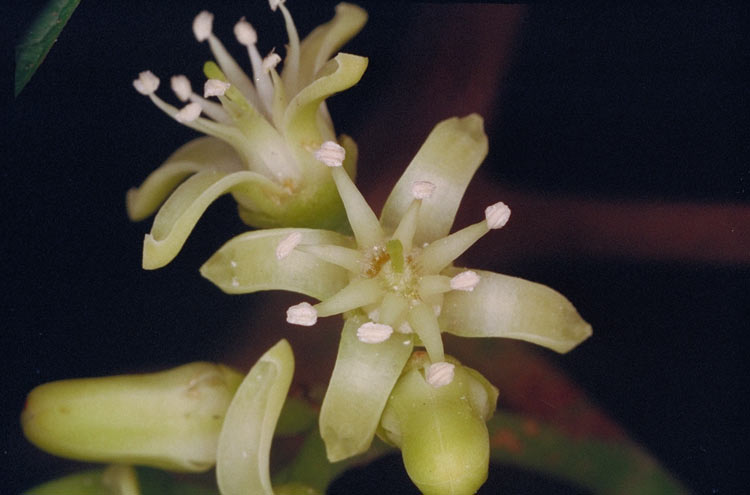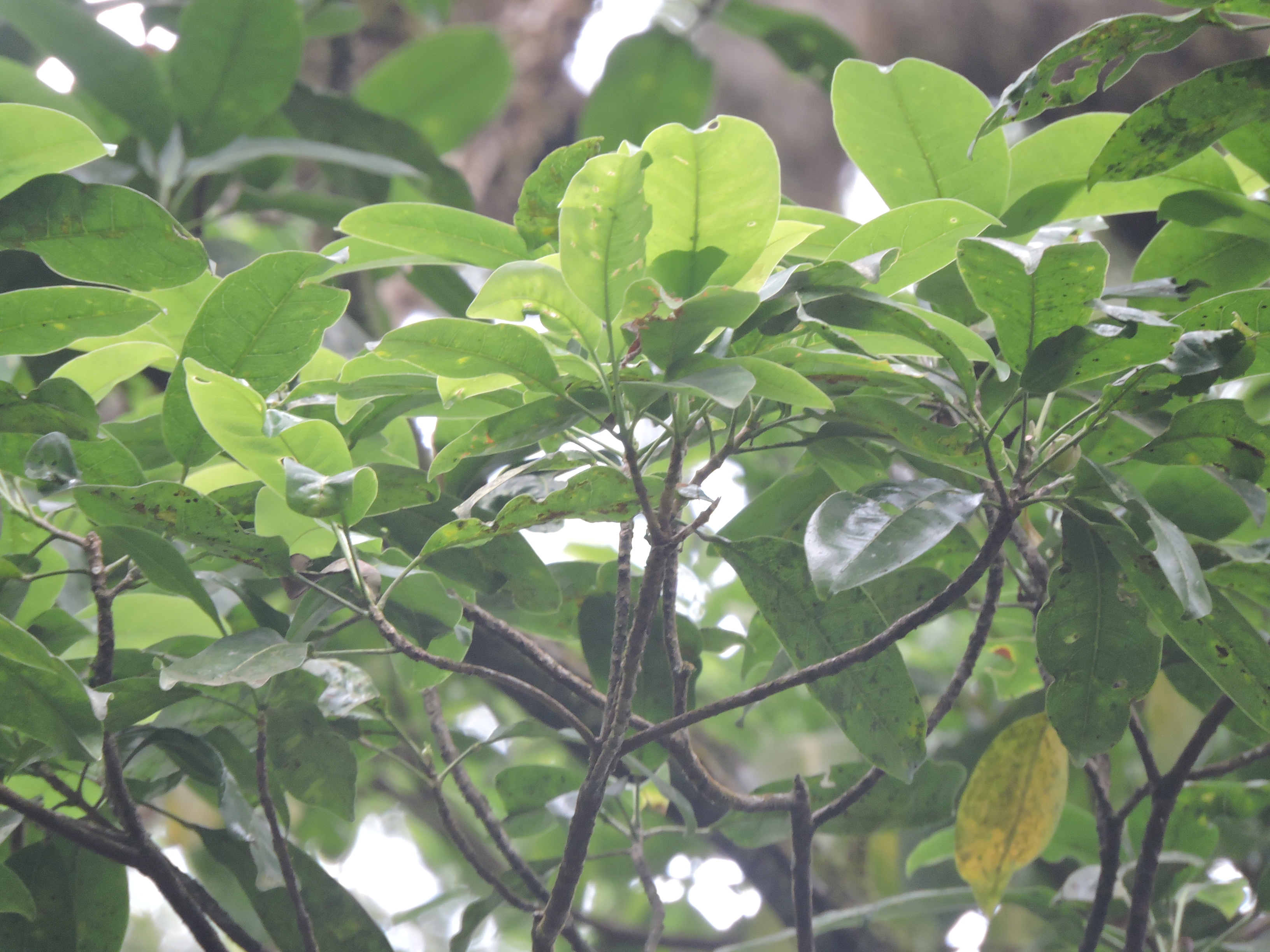|
Acronychia
''Acronychia'' is a genus of about fifty species of plants in the rue family Rutaceae. The leaves are simple or Pinnation, pinnate, and the flowers Plant reproductive morphology#Bisexual, bisexual with four sepals, four petals and eight stamens. They have a broad distribution including in India, Malesia, Australia and the islands of the western Pacific Ocean. About twenty species are Endemism, endemic to Australia. Description Plants in the genus ''Acronychia'' are shrubs or trees with simple or Glossary of leaf morphology#trifoliate, trifoliate leaves arranged in opposite pairs and with oil Gland (botany), glands in the leaves. The flowers are arranged in leaf wikt:axil, axils either singly or in Inflorescence#Determinate or cymose, cymes or panicles. The flowers are bisexual, with four sepals, four petals and eight stamens. The petals are free from each other, as are the stamens. The Stigma (botany), stigma is small, not differentiated from the Style (botany), style, the fruit i ... [...More Info...] [...Related Items...] OR: [Wikipedia] [Google] [Baidu] |
Acronychia Laevis
''Acronychia laevis'', commonly known as hard aspen, glossy acronychia or northern white lilly pilly, is a species of shrub or small tree in the Rutaceae, citrus family, and is Endemism, endemic to eastern Australia. It has simple, elliptical to egg-shaped leaves, groups of creamy white flowers and fleshy, mitre-shaped to spherical fruit. Description ''Acronychia laevis'' is a shrub or small tree that typically grows to a height of . The trunk has fairly smooth, fawn bark with some vertical lines and wrinkles. The leaves are arranged in opposite pairs and are simple, elliptic to egg-shaped with the narrower end towards the base, long and wide on a Petiole (botany), petiole long. The leaves are shiny green on both sides with a blunt or rounded tip and have oil dots that may be seen using a lens and a bright light. The flowers are mainly arranged in leaf wikt:axil, axils in Inflorescence#Determinate or cymose, cymes long, each flower on a Pedicel (botany), pedicel long. The f ... [...More Info...] [...Related Items...] OR: [Wikipedia] [Google] [Baidu] |
Acronychia Acronychioides
''Acronychia acronychioides'', commonly known as white aspen, is a species of small to medium-sized rainforest tree that is endemic to north-eastern Queensland. It has trifoliate leaves with elliptic to egg-shaped leaflets on stems that are more or less cylindrical, creamy yellow flowers in large groups in leaf axils and fleshy, pear-shaped or spherical fruit. Description ''Acronychia acronychioides'' is a tree that typically grows to a height of and has more or less cylindrical stems. The leaves are usually trifoliate on a petiole long. The leaflets are elliptic to egg-shaped with the narrower end towards the base, long and wide on a petiolule up to long. The flowers are arranged in large groups long in leaf axils, each flower on a pedicel long. The four sepals are wide, the four petals long and the eight stamens alternate in length. Flowering occurs from April to May and the fruit is a fleshy, pear-shaped to spherical drupe long. Taxonomy White aspen was first f ... [...More Info...] [...Related Items...] OR: [Wikipedia] [Google] [Baidu] |
Acronychia Acidula
''Acronychia acidula'', commonly known as lemon aspen or lemon wood, is a species of small to medium-sized rainforest tree that is endemic to Queensland. It has simple, elliptical leaves, small groups of flowers in leaf axils and more or less spherical fruit. The aromatic and acidic fruit is harvested as a bushfood. Description ''Acronychia acidula'' is a tree that typically grows to a height of about . It has simple, elliptical, glabrous leaves that are long and wide on a petiole long. The crushed leaves often have an odour resembling that of mango (''Mangifera indica''). The flowers are arranged in groups long, in leaf axils or between the leaves, each flower on a glabrous pedicel long. The four sepals are long and the four petals long. The eight stamens alternate in length. The fruit is a fleshy, more or less spherical drupe long and the seeds are about long. Taxonomy ''Acronychia acidula'' was first formally described in 1864 by Victorian state botanist Ferdina ... [...More Info...] [...Related Items...] OR: [Wikipedia] [Google] [Baidu] |
Acronychia Pedunculata
''Acronychia pedunculata'' is a large shrub or small tree of the understory, gaps and fringes of low country and lower hill tropical forests of tropical Asia. Description Leaves: elliptic to suboblong, often with tapered base. Twigs more or less angular, glabrous. Flowers: greenish white; I-acillary, corymbose panicles, about across in inflorescences of wide. Flowering: February–April, July–August. The fruits are cream to brownish yellow drupes, slightly angled, in diameter with a short apiculate tip. Leaves and fruits, and other parts of the plant, contain aromatic oils with a resinous scent. In Sri Lanka, the flowering time is February–April and July–August. Distribution South and Southeast Asia from India & Sri Lanka to South China & Taiwan, Indochina, Malesia & Papua New Guinea. Local names * * * Nepali: Paolay * Assamese: Laojan * Tamil & Malayalam: Mutta-nari Uses Extracts of its leaves, bark, stems and fruits are widely used in herbal medicinal ap ... [...More Info...] [...Related Items...] OR: [Wikipedia] [Google] [Baidu] |
Acronychia Acuminata
''Acronychia acuminata'', commonly known as Thornton aspen, is a species of shrub or small rainforest tree that is endemic to north-eastern Queensland. It has simple leaves on stems that are more or cylindrical, flowers in small groups in leaf axils and fleshy, oval to spherical fruit. Description ''Acronychia acuminata'' is a tree that typically grows to a height of but flowers when only shrub-sized. It has more or less cylindrical stems and simple, glabous, elliptical leaves long and wide on a petiole long. The flowers are arranged in small groups about long in leaf axils, each flower on a pedicel long. The four sepals are about wide, the four petals about long and the eight stamens alternate in length. Flowering occurs in July and the fruit is a fleshy, oval or spherical drupe long. Taxonomy ''Acronychia acuminata'' was first formally described in 1974 by Thomas Gordon Hartley in the '' Journal of the Arnold Arboretum'' from specimens collected between the Daint ... [...More Info...] [...Related Items...] OR: [Wikipedia] [Google] [Baidu] |
Acronychia Aberrans
''Acronychia aberrans'', commonly known as acid berry, lemon aspen, plasticine tree or plasticene aspen, is a species of medium-sized rainforest tree that is endemic to north-eastern Queensland. It has simple leaves on stems that are more or less square in cross-section, flowers in small groups in leaf axils and fleshy, more or less spherical fruit. Description ''Acronychia aberrans'' is a tree that typically grows to a height of . Its leafy stems are more or less square in cross-section, giving the appearance of having been squeezed like plasticine. The leaves are simple, elliptic to egg-shaped with the narrower end towards the base, long and wide on a petiole long. The flowers are arranged in small groups long in leaf axils, each flower on a pedicel long. The sepals are about wide, the four petals long and the eight stamens alternate in length. Flowering occurs from February to April and the fruit is a fleshy, more or less spherical or pear-shaped drupe long. Taxonom ... [...More Info...] [...Related Items...] OR: [Wikipedia] [Google] [Baidu] |
Carl Linnaeus
Carl Linnaeus (23 May 1707 – 10 January 1778), also known after ennoblement in 1761 as Carl von Linné,#Blunt, Blunt (2004), p. 171. was a Swedish biologist and physician who formalised binomial nomenclature, the modern system of naming organisms. He is known as the "father of modern Taxonomy (biology), taxonomy". Many of his writings were in Latin; his name is rendered in Latin as and, after his 1761 ennoblement, as . Linnaeus was the son of a curate and was born in Råshult, in the countryside of Småland, southern Sweden. He received most of his higher education at Uppsala University and began giving lectures in botany there in 1730. He lived abroad between 1735 and 1738, where he studied and also published the first edition of his ' in the Netherlands. He then returned to Sweden where he became professor of medicine and botany at Uppsala. In the 1740s, he was sent on several journeys through Sweden to find and classify plants and animals. In the 1750s and 1760s, he co ... [...More Info...] [...Related Items...] OR: [Wikipedia] [Google] [Baidu] |
Stigma (botany)
The stigma (: stigmas or stigmata) is the receptive tip of a Gynoecium#Carpels, carpel, or of several fused carpels, in the gynoecium of a flower. Description The stigma, together with the Style (botany), style and ovary (botany), ovary (typically called the stigma-style-ovary system) comprises the pistil, which is part of the gynoecium or female reproductive organ of a plant. The stigma itself forms the distal portion of the style, or stylodia, and is composed of , the cells of which are receptive to pollen. These may be restricted to the apex of the style or, especially in wind pollinated species, cover a wide surface. The stigma receives pollen and it is on the stigma that the pollen grain germination, germinates. Often sticky, the stigma is adapted in various ways to catch and trap pollen with various hairs, flaps, or sculpturings. The pollen may be captured from the air (wind-borne pollen, anemophily), from visiting insects or other animals (Pollination syndrome#Biotic, ... [...More Info...] [...Related Items...] OR: [Wikipedia] [Google] [Baidu] |
Georg Forster
Johann George Adam Forster, also known as Georg Forster (; 27 November 1754 – 10 January 1794), was a German geography, geographer, natural history, naturalist, ethnology, ethnologist, travel literature, travel writer, journalist and revolutionary. At an early age, he accompanied his father, Johann Reinhold Forster, on several scientific expeditions, including James Cook's Second voyage of James Cook, second voyage to the Pacific Ocean, Pacific. His report of that journey, ''A Voyage Round the World'', contributed significantly to the ethnology of the people of Polynesia and remains a respected work. As a result of the report, Forster, who was admitted to the Royal Society at the early age of twenty-two, came to be considered one of the founders of modern scientific travel literature. After returning to continental Europe, Forster turned toward academia. He taught natural history at the Collegium Carolinum (Kassel), Collegium Carolinum in the Ottoneum, Kassel (1778–84), a ... [...More Info...] [...Related Items...] OR: [Wikipedia] [Google] [Baidu] |
Joseph Gaertner
Joseph Gaertner (12 March 1732 – 14 July 1791) was a German botanist, best known for his work on seeds, ''De Fructibus et Seminibus Plantarum'' (1788-1792). Biography He was born in Calw, and studied in Göttingen under Albrecht von Haller. He was primarily a naturalist, but also worked at physics and zoology. He travelled extensively to visit other naturalists. He was professor of anatomy in Tübingen in 1760, and was appointed professor of botany at St Petersburg in 1768, but returned to Calw in 1770. Gaertner made back cross to convert one species into another. Back cross increases nuclear gene frequency His observations were: 1. Dominance of traits 2. Equal contribution of male and female to the progeny 3. No variation in F1 (first generation of descendants) 4. Large variation in F2 (second generation of descendants) including parental and intermediate types 5. Some of F2 plants had entirely new traits but he was unable to give possible explanation for observed dat ... [...More Info...] [...Related Items...] OR: [Wikipedia] [Google] [Baidu] |
Plants Of The World Online
Plants of the World Online (POWO) is an online taxonomic database published by the Royal Botanic Gardens, Kew. History Following the Convention on Biological Diversity, the Royal Botanic Gardens in Kew launched Plants of the World Online in March 2017 with the goal of creating an exhaustive online database of all seed-bearing plants worldwide. (Govaerts wrongly speaks of "Convention for Botanical Diversity (CBD)). The initial focus was on tropical African flora, particularly flora ''Zambesiaca'', flora of West and East Tropical Africa. Since March 2024, the website has displayed AI-generated predictions of the extinction risk for each plant. Description The database uses the same taxonomical source as the International Plant Names Index, which is the World Checklist of Vascular Plants (WCVP). The database contains information on the world's flora gathered from 250 years of botanical research. It aims to make available data from projects that no longer have an online ... [...More Info...] [...Related Items...] OR: [Wikipedia] [Google] [Baidu] |
Salicaceae
The Salicaceae are the willow family of flowering plants. The traditional family (Salicaceae ''sensu stricto'') includes the willows, poplars. Genetic studies summarized by the Angiosperm Phylogeny Group (APG) have greatly expanded the circumscription of the family to contain 56 genera and about 1220 species, including the tropical Scyphostegiaceae and many of the former Flacourtiaceae. In the Cronquist system, the Salicaceae were assigned to their own order, Salicales, and contained three genera, ''willow, Salix'', ''Populus'', and ''Chosenia'' (now a synonym of ''Salix''). Recognized to be closely related to the Violaceae and Passifloraceae, the family is placed by the APG in the order Malpighiales. Under the new circumscription, most members of the family are trees or shrubs that have Simple leaf, simple leaves with Phyllotaxis, alternate arrangement, and temperate members are usually deciduous. Most members have serrate or dentate leaf margins, and many of those that have s ... [...More Info...] [...Related Items...] OR: [Wikipedia] [Google] [Baidu] |






